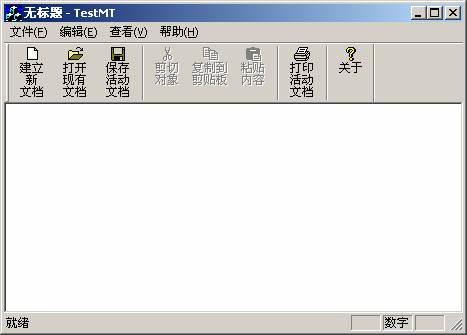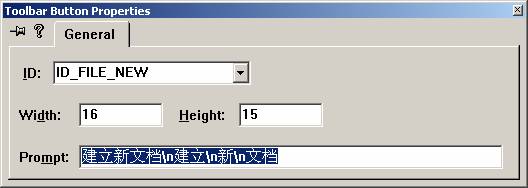界面顯示效果如圖一:

圖一 例子程序運行畫面
CToolBar不支持多行文字,本文將通過一個定制的MFC/C++類 CMTToolBar 實現在工具條中顯示多行文字。其思路是先把文字變成位圖,再替換原來的工具條位圖,達到顯示多行文字的效果。這個類中最主要的一個成員函數是ShowText(UINT nIDResource),其定義如下:
// 顯示工具條文字
BOOL CMTToolBar::ShowText(UINT nIDResource)
{
// determine location of the bitmap in resource fork
HINSTANCE hInst = AfxFindResourceHandle(MAKEINTRESOURCE(nIDResource), RT_TOOLBAR);
HRSRC hRsrc = ::FindResource(hInst, MAKEINTRESOURCE(nIDResource), RT_TOOLBAR);
if (hRsrc == NULL)
return FALSE;
HGLOBAL hGlobal = LoadResource(hInst, hRsrc);
if (hGlobal == NULL)
return FALSE;
CToolBarData* pData = (CToolBarData*)LockResource(hGlobal);
if (pData == NULL)
return FALSE;
ASSERT(pData->wVersion == 1);
// 得到單個按鈕的圖像大小
CSize sizeImage(pData->wWidth, pData->wHeight);
// release the resource
UnlockResource(hGlobal);
FreeResource(hGlobal);
// 得到 CToolBarCtrl
CToolBarCtrl& bar = GetToolBarCtrl();
// 得到 ToolBarCtrl的DC
CDC *pdcCtrl = bar.GetDC();
CDC dcDst; // 目標DC , 用於生成新位圖
dcDst.CreateCompatibleDC(pdcCtrl);
// 新建字體
LOGFONT logFont;
ZeroMemory(&logFont,sizeof(logFont));
logFont.lfWidth = 6;
logFont.lfHeight = 12;
logFont.lfCharSet = GB2312_CHARSET;
strcpy(logFont.lfFaceName, "宋體" );
CFont fntNew;
fntNew.CreateFontIndirect(&logFont);
CFont *pfntOld = dcDst.SelectObject(&fntNew);
// 新單個按鈕的圖片大小
CSize sizeNewImage(sizeImage.cx, 0);
// 創建字符串數組
const int nCount = bar.GetButtonCount();
CStringArray *pstrArray = new CStringArray[nCount];
int nLines = 0; // 文字行數
int nIndex = 0;
int nCharHeight = 0; // 單個字符高度
TBBUTTON tb;
int nBtnCount = 0; // 按鈕個數(除去分隔條)
for (int i = 0; i < nCount; ++ i)
{
ZeroMemory(&tb, sizeof(TBBUTTON));
bar.GetButton(i, &tb);
// 如果是分隔條
if ((tb.fsStyle & TBSTYLE_SEP) == TBSTYLE_SEP)
{
continue;
}
CString strT;
strT.LoadString(tb.idCommand);
int nPos = strT.Find(_T(''n'')) + 1;
while(nPos > 0)
{
int nPos2 = strT.Find(_T(''n''), nPos);
int nIndex;
if(nPos2>nPos)
{
nIndex = pstrArray[nBtnCount].Add( strT.Mid(nPos, nPos2-nPos) );
nPos = nPos2 + 1;
}
else if(strT.GetLength() > nPos)
{
nIndex = pstrArray[nBtnCount].Add( strT.Mid(nPos) );
nPos = -1;
}
nLines = max(nLines, nIndex+1);
CSize size = dcDst.GetTextExtent(pstrArray[nBtnCount][nIndex]);
nCharHeight = max(size.cy, nCharHeight);
sizeNewImage.cx = max(size.cx, sizeNewImage.cx);
}
nBtnCount ++;
}
// 換算成實際像素
sizeNewImage.cy = nLines*nCharHeight;
// 讀取工具條位圖資源
CBitmap bmpToolBar;
BITMAP bmBitmap;
if (!bmpToolBar.Attach(LoadImage(AfxGetInstanceHandle(),
MAKEINTRESOURCE(nIDResource),
IMAGE_BITMAP, 0, 0,
LR_DEFAULTSIZE|LR_CREATEDIBSECTION
|LR_LOADMAP3DCOLORS )) ||
!bmpToolBar.GetBitmap(&bmBitmap))
return FALSE;
// 取得位圖總寬高
int nWidth = bmBitmap.bmWidth;
int nHeight = bmBitmap.bmHeight;
// 新位圖的總寬高
int nWidthNew = sizeNewImage.cx * nBtnCount;
sizeNewImage.cy += nHeight;
int nHeightNew = sizeNewImage.cy;
CDC dcSrc; // 源DC
dcSrc.CreateCompatibleDC(pdcCtrl);
CBitmap *pbmpOldSrc = dcSrc.SelectObject(&bmpToolBar);
CBitmap bmpDst; // 新位圖
bmpDst.CreateCompatibleBitmap(&dcSrc, nWidthNew, nHeightNew);
CBitmap *pbmpOldDst = dcDst.SelectObject(&bmpDst);
// 先填充背景色
dcDst.FillSolidRect(CRect(0, 0, nWidthNew, nHeightNew), ::GetSysColor(COLOR_BTNFACE));
dcDst.SetBkMode(TRANSPARENT); // 設置透明背景方式
int nStartX = (sizeNewImage.cx-sizeImage.cx)/2; // 計算開始橫坐標,用於居中處理
// 開始制作工具條位圖
for( i = 0; i < nBtnCount; ++ i)
{
dcDst.BitBlt(i*sizeNewImage.cx+nStartX, 0, sizeImage.cx, sizeImage.cy,
&dcSrc, i*sizeImage.cx, 0, SRCCOPY);
int j;
for(j = 0; j < pstrArray[i].GetSize(); j ++)
{
CSize size = dcDst.GetTextExtent(pstrArray[i][j]);
int nStratX = (sizeNewImage.cx-size.cx)/2;
dcDst.TextOut(i*sizeNewImage.cx+nStratX, sizeImage.cy+j*nCharHeight, pstrArray[i][j]);
}
}
// 恢復DC並釋放資源
dcSrc.SelectObject(pbmpOldSrc);
dcDst.SelectObject(pbmpOldDst);
dcDst.SelectObject(pfntOld);
bar.ReleaseDC(pdcCtrl);
delete [] pstrArray;
// 重新設置大小
SetSizes(sizeNewImage + CSize(7,7), sizeNewImage);
// 替換工具條位圖
//SetBitmap((HBITMAP)bmpDst.Detach());
AddReplaceBitmap((HBITMAP)bmpDst.Detach());
return TRUE;
} 使用的時候只需要簡單在工具條資源裡添加文字,每行用n分開,如圖二所示:

圖二 在工具條資源裡添加文字
再用CMTToolBar替換原CToolBar類。調用一下BOOL CMTToolBar::ShowText(UINT nIDResource) 就成了。
nIDResource是工具條資源id。
本文示例代碼或素材下載